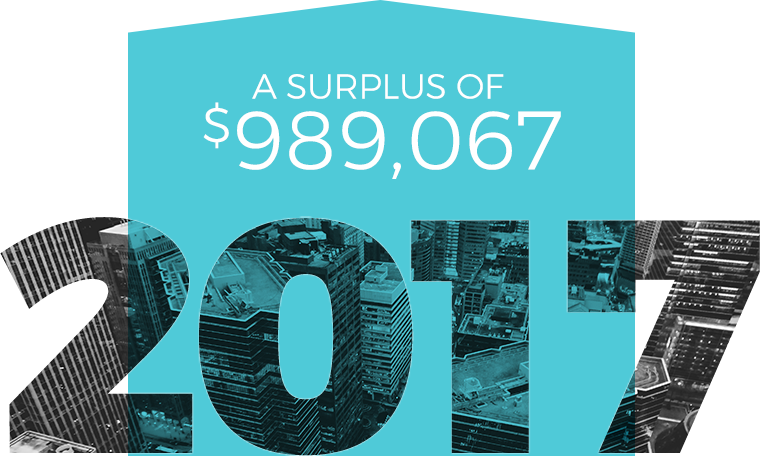FINANCIAL REPORT
MANAGEMENT DISCUSSION AND ANALYSISFor the Year Ended December 31, 2017
Management’s discussion and analysis of the financial results of operations of the Ontario Real Estate Association (OREA) should be read in conjunction with the audited financial statements for the year ended December 31, 2017.
The Auditors have examined the books, records and financial systems in place and provided OREA with a clean audit report. The audited OREA financial statements for 2017 have been approved by the OREA Board of Directors.

Overview
OREA is Canada’s largest provincial association representing more than 71,000 real estate professionals in 2017 working through its Member Boards in Ontario.
OREA has two main streams of activities – Member Services and OREA Real Estate College. The operating philosophy has been to manage separately the finances of the two main departments. In other words, we do not use the dues dollars to subsidize the College activities, nor do we use the course revenues to finance member services.

The 2017 fiscal year ended with a surplus of $989,067 for Member Services activities due to prudent program spending and cost savings in administrative activities. With the growth of 5 per cent in dues revenues, it could have been easier to postpone spending reductions or forego efficiencies in programs and operating costs. However, fiscal constraint and discipline on expense control was maintained. Our efforts in finding savings and setting priorities allowed us to reinvest funds to priority programs such as government relations, communications and member services. The mandate to better respect members’ dues in the CEO’s Fresh Eyes Report was implemented – significant cost cutting measures were introduced, resulting in management restructuring, reductions in staffing, lower meetings costs for food and hospitality, and termination of consultants’ contracts. The OREA Board of Directors continued to lead by example with reductions in governance costs by 25 per cent. The CEO and OREA staff reduced their travel expenses by 50 per cent.
On the College side, there was 16 per cent increase in revenues due to the significantly higher course enrolments activities. Discretionary program costs were cut back. This led to a surplus of $10,449,342 for the College. As approved by the OREA Board of Directors, the College surplus has been transferred to the College Contingency Reserve Fund to help finance the closing costs of the College.

The total surplus for the Association was $11.4 million for 2017

MEMBER SERVICES – Revenues
The revenues received in 2017 were from various activities as shown below:
Membership highlights for 2017:
- Increased membership with 5.4 per cent growth in dues revenues
- Decrease of 23 per cent in numbers of new individual members joining Ontario boards
| OREA Membership Statistics | ||||||
| 2017 | 2016 | 2015 | 2014 | 2013 | 2012 | |
| Members (January 1st) | 69,067 | 64,242 | 61,250 | 58,781 | 55,474 | 53,291 |
| OREA Annual Dues | $110 | $110 | $110 | $110 | $110 | $110 |
| OREA Dues Revenue ($000’s) | $7,994 | $7,584 | $7,125 | $6,862 | $6,605 | $6,291 |
| % Change | 5.4% | 6.4% | 3.8% | 3.9% | 5.0% | 4.9% |
| New Members | 5,787 | 7,522 | 6,387 | 5,744 | 6,000 | 5,769 |
| New Member Initiation Fee | $200 | $200 | $200 | $200 | $200 | $200 |
| Initiation Fees Revenues ($000’s) | $1,157 | $1,504 | $1,277 | $1,149 | $1,200 | $1,154 |
| % Change | -23.1% | 17.7% | 11.2% | -4.3% | 4.0% | 4.4% |
MEMBER SERVICES – Program Expenses
Membership dues and initiation fees revenues were used to support the following significant member services and programs:
- Government relations successfully advocated for mandatory designated representation, the Employment Standards Act, Tax Fairness for REALTORS®, HER&D and the review of REBBA. OREA also successfully organized the first ever Ontario Housing Summit and the very successful 2017 Ontario REALTOR® Party Conference.
- Communications significantly increased member board outreach and media coverage for OREA, and started work on the communications audit of the Association.
- Public Affairs launched a new OREA.com website, a fully rebranded REALiTY Conference, trade shows, sponsorship programs and significantly increased engagement on OREA’s social media platforms.
- Emerge Regional Conferences included eight area events across the province, two of which were for commercial services. The Emerge conferences examine the latest tools and technologies in the real estate marketplace. A panel of industry experts presented their insights on a variety of technology-related topics at each event.
- Young Professionals Network services which included support for local member board YPN chapters, travel and meetings.
- Commercial services included promotion of commercial REALTOR® value, sponsorship of local board commercial events, travel and meetings.
- Leadership Events/Forums covered a wide range of services offered to Real Estate boards, Executive Officers, Presidents, President-Elects and other volunteer leaders from directors to committee members.
- It is estimated that there are 1,500-2,000 volunteers. No other real estate association in North America offers the depth and breadth of OREA’s volunteer leadership programs.
- In 2017, it included the Building Leadership Through Communication (BLTC) program which includes media training, presentation skills and conflict resolution.
- Peak Leadership Summit – This was the second year of combining three events – President/President-Elect meeting, EO Summit and Partnership Forum. It was held in January 2017 and had high attendance with 103 Board Leaders representing 37 Member Boards.
- Legal Department Services include Legal Forum, the RECO Complaints Process Service and the OREA Arbitration Appeal Hearings and Arbitration Hearings. In addition, the Legal Department continues to provide assistance to the Ontario real estate boards with compliance efforts with respect to the Accessibility for Ontarians with Disabilities Act, 2005 (‘AODA’) and its Accessibility Standards, communicates with real estate board Executive Officers daily, and fields questions with respect to governance and legal matters. Some questions of a general nature are currently posted in the Legal FAQs for Board Executive Officers under the Legal Resource section on www.orea.com. The legal expenses incurred in 2017 were less than the previous year largely due to increased work done in-house and reduced spending on outside counsel and litigation and tax matters.
OREA REAL ESTATE COLLEGE
Revenues and Expenses – 2017
The OREA College posted a surplus of $10,449,342 in 2017 that was due to significantly increased enrolment activities for registration education courses during the year. The increase was largely in the articling phase of the Salesperson program, in addition to the overall strong showing in enrolments activities due to the highly active real estate market.
The course enrolment trend at the OREA College for Real Estate as a Professional Career, the first course in the Registration Education program, for the past three years is shown below:
Significant items in the OREA Real Estate College statement of revenues and expenses for 2017 included:
- Salesperson program enrolments were 77,392 (12 per cent ahead of 2016).
- Brokerage program enrolments were 3,311 (28 percent higher than 2016).
- Registration education courses material expenses were higher than previous year due to higher enrolment activities.
- Payments to RECO for registration education courses were $3.1 million.
- Private Career Colleges Act (PCCA) related premium and financing costs for 2017 were $177,854. This is higher than in 2016 due to higher enrolment levels.
| Salaries and Benefits Analysis | 2017 | 2016 | 2015 | 2014 | 2013 |
| Total OREA Staff Salaries and Benefits ($000’s) | 11,180 | 11,928 | 10,700 | 10,148 | 10,421 |
| Salaries and Benefits as % of Total Expenses | 26.2% | 27.8% | 28.7% | 30.3% | 29.7% |
| Number of Staff | 98 | 109 | 107 | 111 | 105 |
- Organizational restructuring resulted in terminations of 16 staff members. With new hiring of staff in the areas of government relations, communications and standard forms, there was a net loss of 11 staff in 2017.
- Staff salaries include severance costs and the additional costs were offset by savings from delayed hiring for staff vacancies.
In 2017, the expenditures for special projects approved by the Board of Directors for funding from Designated Reserves totaled to $432,672. The investment income of $435,299 from Designated Reserves funds was used to fund these member benefits projects. The special projects included Governance Review, REBBA Review, Ontario REALTOR® Party, Mandatory Home Energy Audit Campaign, Political Action Task Force Projects, 2017 OREA Spring Political Affairs Seminar, Public Relations-Multiple Representation, and OREA’s contribution for administrative costs of the Ontario REALTORS Care® Foundation.
The financial status of the Association is healthy with net assets of $45.7 million at December 31, 2017. The significant items included therein are:
- Designated reserves of $27.8 million
- Investments in property and equipment of $8.4 million
- Net unrestricted assets of $9.5 million
Deferred revenue includes course fees of $3.5 million received from students in advance for courses scheduled after December 31, 2017.
OREA and the Ontario REALTORS Care® Foundation have common membership and the financial statements of the Ontario REALTORS Care® Foundation are provided separately. OREA contributed $133,000 to the Ontario REALTORS Care® Foundation for administrative expenses in 2017 (same as in 2016). In addition, OREA provided certain in-kind services to the Foundation.
FUTURE OUTLOOK
The 2018 OREA Budget is based on the strategic initiatives of OREA Board of Directors and reflects economic changes and the current business climate. The Association has made bold and difficult decisions to prepare four-years’ financial projections (2018-2021) and plans for a financially stable, and revitalized OREA with a balanced budget in 2021, after seeing through the closure of the OREA College in 2020.

| Financial Projections for 2018 — 2021 | |||||
| 2017 | 2018 * | 2019 * | 2020 * | 2021 * | |
| ($000’s) | ($000’s) | ($000’s) | ($000’s) | ($000’s) | |
| Revenues | |||||
| Member Services | $10,049 | $10,670 | $10,216 | $10,469 | $10,023 |
| College – Registration Education | $44,551 | $28,558 | $11,706 | $1,949 | – |
| Total Revenues | $54,600 | $39,228 | $21,922 | $12,418 | $10,023 |
| Member Services Revenues as a % of Total Revenues | 18.4% | 27.2% | 46.6% | 84.3% | 100% |
| Expenses | |||||
| Member Services Direct Costs | $7,719 | $8,314 | $7,850 | $8,545 | $8,188 |
| College – Registration Education | $31,234 | $23,001 | $12,057 | $7,337 | – |
| Other Operating Costs | $4,209 | $4,347 | $3,738 | $3,340 | $1,835 |
| Total Expenses | $43,162 | $35,662 | $23,645 | $19,222 | $10,023 |
| Total Surplus (Deficit) | $11,438 | $3,566 | ($1,723) | ($6,804) | – |
| Transfer to/(from) College Contingency | $10,449 | $2,941 | ($1,791) | ($6,287) | – |
| Government Relations – New Initiatives * | – | $625 | $625 | $625 | – |
| Net Surplus (Deficit) | $989 | – | ($557) | ($1,142) | – |
* Projections are based on current programs and levels of member services.
Note: New initiatives proposed for 3 years 2018-2020 (include Municipal Advocacy Grants program $120k; ORP projects $325k; Policy Research $180k); programs eliminated in 2021 unless new funds available
The OREA Board of Directors is fully committed to streamlining the Association’s activities to make them more cost effective while keeping them relevant to member needs.
For 2018, membership dues projections reflect 3 per cent growth in membership based on input from real estate boards in Ontario and CREA, College enrolment activities and economic outlook. Member Services activities have been budgeted on a break-even basis.
OREA College Budget reflects reduced enrolment activities based on the economic outlook in 2018. It is gearing towards closing its operations by December 31, 2020 due to the loss of the Education Services Agreement with the Real Estate Council of Ontario.